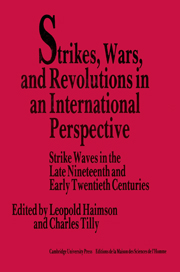 Strikes, Wars, and Revolutions in an International Perspective
Strikes, Wars, and Revolutions in an International Perspective Published online by Cambridge University Press: 25 March 2010
Introduction
The aim of this paper is to provide a synthetic, quantitative analysis of labor conflicts in Italy as they are recorded in official strike statistics from the last decades of the nineteenth century to the ascent of fascism. The qualification, “as they are recorded by the official statistics on strikes,” imposes two limits. First, forms of industrial unrest other than strikes, such as boycotts, restriction of output, and absenteeism and sabotage, will not be considered here. If it is true that these various types of conflict are to some extent interchangeable (Knowles 1952, 285), and that restricting one specific manifestation might “merely divert the conflict to other forms” (Hyman 1972, 55), this limitation will be particularly significant in the Italian context, where especially during the first decades analyzed here, the legal and political environment was rather hostile both to unionization and to industrial strikes.
Second, the official statistics provided by the government record only “economic” strikes, that is, “those which aim to obtain better working conditions directly from the employer.” Excluded are “political” strikes and those aiming to obtain the passage of some specific legislation or to achieve economic improvements through government measures. It could be, as one Italian scholar put it (Foa, 1975, 1799), that in Italy even more than in other countries the strike movement captured only a portion of labor activity, and that the social strains of the period are better expressed by indices such as migration, crime, and massacres.
To save this book to your Kindle, first ensure [email protected] is added to your Approved Personal Document E-mail List under your Personal Document Settings on the Manage Your Content and Devices page of your Amazon account. Then enter the ‘name’ part of your Kindle email address below. Find out more about saving to your Kindle.
Note you can select to save to either the @free.kindle.com or @kindle.com variations. ‘@free.kindle.com’ emails are free but can only be saved to your device when it is connected to wi-fi. ‘@kindle.com’ emails can be delivered even when you are not connected to wi-fi, but note that service fees apply.
Find out more about the Kindle Personal Document Service.
To save content items to your account, please confirm that you agree to abide by our usage policies. If this is the first time you use this feature, you will be asked to authorise Cambridge Core to connect with your account. Find out more about saving content to Dropbox.
To save content items to your account, please confirm that you agree to abide by our usage policies. If this is the first time you use this feature, you will be asked to authorise Cambridge Core to connect with your account. Find out more about saving content to Google Drive.